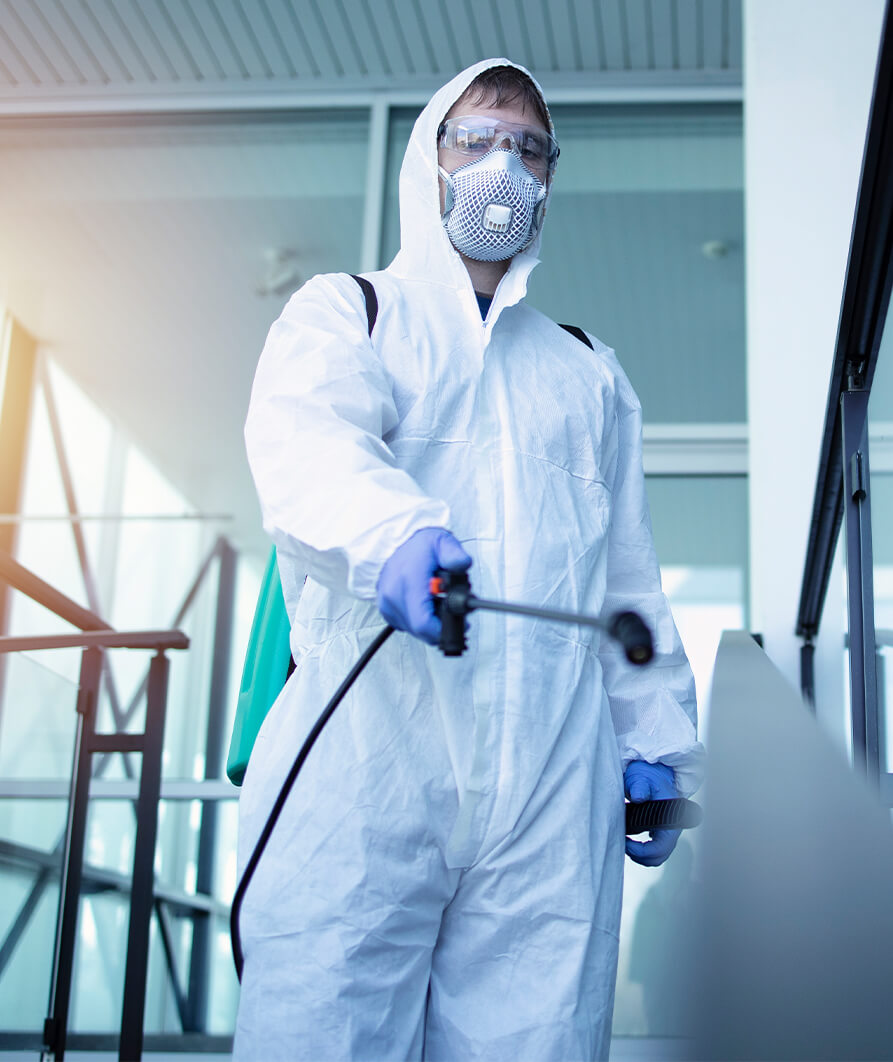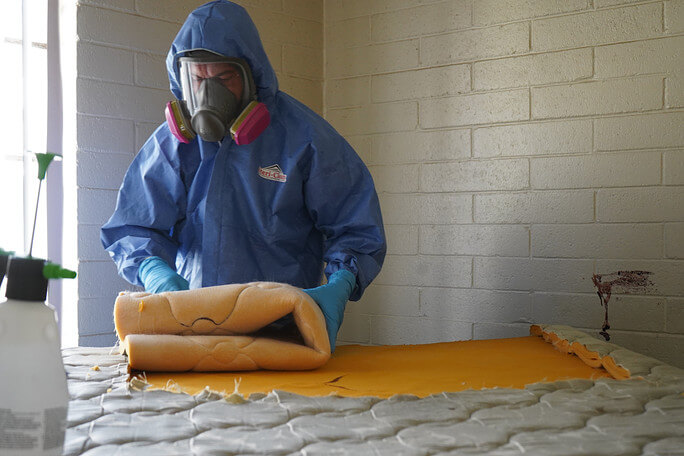Biohazard Removal: Safe Handling and Disposal of Hazardous Products
Biohazard Removal: Safe Handling and Disposal of Hazardous Products
Blog Article
Expert Biohazard Cleansing and Purification for Blood, Bodily Fluids, and Hazardous Products
In the world of biohazard cleansing and decontamination for blood, bodily liquids, and harmful materials, precision and competence are critical. The potential health and wellness risks associated with direct exposure to biohazards emphasize the essential need for precise handling and thorough cleanup. Specialized training equips specialists with the understanding and skills essential to attend to these dangerous scenarios successfully. However, it is not just about tidying up; the importance of employing proper purification techniques can not be overemphasized. As we navigate the complex landscape of biohazard cleanup, understanding the nuances of regulations, compliance, and the specific devices at play becomes imperative in guaranteeing a extensive and risk-free decontamination procedure.
Health And Wellness Risks of Biohazard Direct Exposure
Direct exposure to biohazards poses considerable health and wellness dangers that can cause extreme consequences for individuals and communities alike. Biohazards incorporate a wide variety of organic materials, consisting of blood, bodily fluids, mold, microorganisms, viruses, and various other potentially transmittable materials. When individuals enter into contact with these biohazards, whether via crashes, improper handling, or environmental exposure, they encounter the threat of having significant diseases or illness.
One of the main health and wellness risks related to biohazard direct exposure is the transmission of infectious illness. Bloodborne microorganisms such as HIV, hepatitis B and C, and various microorganisms can be existing in biohazardous materials, presenting a direct hazard to human health and wellness. Breathing in air-borne biohazards like mold and mildew spores or entering call with contaminated surface areas can likewise bring about breathing problems, allergies, and various other damaging health and wellness results.
Furthermore, biohazard direct exposure can have long-lasting health implications, with some conditions materializing years after the preliminary contact (Blood Cleanup). For that reason, it is essential to focus on appropriate biohazard cleaning and purification to reduce these health dangers and make certain the safety and security of people and neighborhoods

Specialized Training for Biohazard Clean-up
When it comes to managing biohazard cleaning efficiently and safely, specialized training plays a basic role in guaranteeing correct decontamination procedures are complied with. Biohazard cleaning requires particular understanding and abilities to effectively reduce dangers linked with bloodborne pathogens, bodily liquids, and unsafe products. Professionals learnt biohazard cleanup go through extensive direction on just how to securely take care of, remove, and throw away biohazardous products to avoid contamination and exposure.
Specialized training for biohazard cleanup covers a series of important topics, including appropriate personal protective tools (PPE) usage, bloodborne pathogen awareness, purification strategies, and contaminated materials disposal methods. People educated in biohazard cleaning are outfitted with the essential competence to assess contamination levels, recognize possible dangers, and carry out proper clean-up procedures in compliance with governing criteria.
Continual training and education and learning are extremely important in the field of biohazard cleanup to remain upgraded on the most up to date decontamination technologies, safety and security methods, and policies. By investing in specialized training, biohazard cleanup specialists can successfully reply to emergency cleaning circumstances and safeguard both public wellness and the atmosphere.
Significance of Correct Decontamination Methods
Utilizing correct decontamination strategies is vital in biohazard clean-up to properly get rid of dangerous products and reduce health dangers. Reliable decontamination not just guarantees the elimination of visible traces of blood, physical liquids, and other biohazards but also targets unseen pathogens that might pose significant health hazards if not appropriately removed. By adhering to stringent decontamination procedures, educated professionals can dramatically decrease the danger of direct exposure to harmful bacteria, infections, and bacteria that might bring about infections or illness.
Correct decontamination methods include using specialized devices and anti-bacterials that are particularly made to neutralize biohazards efficiently. Thorough cleaning and disinfection of polluted locations are essential to avoid the spread of microorganisms and make sure a secure setting for occupants. Additionally, the appropriate disposal of biohazardous waste complying with decontamination treatments is crucial in protecting against contamination of other surface areas or people.

Tools and Devices for Safe Clean-up
The proper equipment and devices crime scene cleanup stories play a critical duty in making sure the effective and secure clean-up of biohazardous products. When managing blood, bodily fluids, or unsafe materials, biohazard cleaning specialists depend on specialized gear to decrease exposure risks and thoroughly sanitize the damaged area. Individual protective equipment (PPE) such as handwear covers, goggles, masks, and coveralls are vital to secure against straight contact with possibly infectious products. Additionally, biohazard cleansing kits consisting of disinfectants, absorptive materials, and biohazard bags are used to securely include and get rid of of contaminated products. Blood Cleanup.
Advanced cleansing devices like hospital-grade disinfectants, HEPA-filtered vacuums, and fogging equipments are used to sanitize surfaces and get rid of biohazards efficiently. Specialized devices such as sharps containers and biohazard garbage disposal containers are utilized to safely handle sharp items and biohazardous waste products. By making use of the appropriate equipment and tools, biohazard cleaning experts can guarantee a thorough cleanup process that prioritizes security and lessens health and wellness threats for both employees and owners of the damaged room.
Rules and Conformity in Biohazard Cleansing
Appropriate adherence to laws and conformity criteria is extremely important in biohazard cleansing to make certain the safety and security of both employees and the setting. Federal government firms such as OSHA (Occupational Safety And Security and Wellness Management) and the EPA (Epa) have developed details standards for biohazard cleaning treatments to lessen health and wellness risks and environmental contamination. These regulations cover a range of facets consisting of the handling, transport, and disposal of biohazardous materials, as well as the necessary training and safety devices required for personnel involved in the cleaning procedure.
Biohazard cleaning companies must remain updated with these policies to guarantee that their operations meet the required safety and security requirements. Failure to adhere read this to these guidelines can result in severe effects, including fines, lawsuit, and jeopardizing the health and wellness of individuals and the atmosphere. By following rigorous laws and compliance measures, biohazard cleaning business can successfully mitigate threats and guarantee a extensive and safe clean-up process for all parties entailed.
Conclusion
Finally, biohazard cleaning and purification require specific training, correct techniques, and adherence to laws. Direct exposure to blood, bodily fluids, and unsafe materials postures considerable wellness risks, making it critical to use the ideal tools and tools for risk-free cleaning. By complying with strict procedures and standards, professionals can efficiently alleviate the threats related to biohazard exposure and make sure the safety and security of both themselves and others.
As we navigate the elaborate landscape of biohazard clean-up, recognizing the subtleties of policies, compliance, and the specific tools at play comes to be necessary in ensuring a safe and extensive purification procedure. (Blood Cleanup)
When it comes to handling biohazard cleanup efficiently and securely, specialized training plays a fundamental duty in ensuring proper decontamination procedures are followed.Utilizing proper purification strategies is crucial in biohazard cleanup to effectively eliminate hazardous materials and lessen health risks. Additionally, biohazard cleansing packages consisting of anti-bacterials, absorptive materials, and biohazard bags are used to securely contain and dispose of infected things.
Federal government agencies such as OSHA (Occupational Safety and Wellness Management) and the EPA (Environmental Security Agency) have actually established specific standards for Get the facts biohazard clean-up procedures to minimize health and wellness threats and ecological contamination.
Report this page